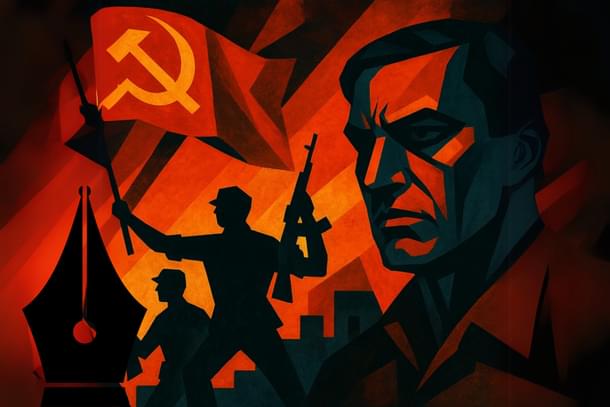Commentary
Red Corridor's Mystery: How India’s Deadliest Insurgency Was Kept Alive For Decades
Naga Praneeth Kalisetty
May 28, 2025, 01:30 PM | Updated Jul 01, 2025, 09:25 AM IST
Save & read from anywhere!
Bookmark stories for easy access on any device or the Swarajya app.


In May 2025, when security forces eliminated Nambala Keshava Rao, the Maoist commander behind some of India’s worst massacres of security personnel, it should have been a moment of national closure. Yet, the CPI and CPI(M) denounced the operation as “extra-judicial” and “inhumane.” That response wasn’t merely distasteful; it was revealing.
It exposed the deeper mystery that continues to haunt India: how has an ultra-violent, armed insurgency that began in the 1960s not only endured but continued to inflict damage for over six decades?
This is not the story of a resilient rebellion. It is the story of a movement repeatedly rescued by politicians who used it, governments that tolerated it, and intellectuals who romanticized it. It was bailed out, dressed up, marketed, and even given state legitimacy. Naxalism survived not because it was strong, but because it was shielded.
Politicians Who Fed the Fire
In its early years, the Naxalite movement should have been crushed while it was still fragmented and regionally confined. Instead, it found unlikely collaborators within mainstream politics.
Multiple former Congress ministers admitted to a High Court Committee that they routinely sought the help of Naxalites during elections in Andhra Pradesh. This wasn’t a one-off tactic but an electoral strategy that spanned cycles. In Chhattisgarh, former Chief Minister Ajit Jogi’s coordination with Maoists followed the same pattern. These were not acts of political desperation but deliberate choices that gave legitimacy and resources to insurgents.
This wasn’t limited to covert deals. Instead of being eradicated, this movement was rewarded. Some ex-Naxalites were absorbed directly into political life. Adhir Ranjan Chowdhury, with known Naxalite roots since his school days, rose through the Congress ranks to become Murshidabad District President in 1999 and the West Bengal State Congress President in 2020. His political success (he won the Behrampore seat every time from 1999 to 2024) whitewashed a past that, in any functioning democracy, should have disqualified him.
This early political patronage normalized the idea that one could move from bullets to ballots without accountability. Worse, it sent a message to active insurgents: political rehabilitation was always on the table.
When the State Blinked
The bloodiest phase of the movement came in the 2000s. Between 2006 and 2010, casualty figures skyrocketed. For any rational state, this would have been the time to apply overwhelming force. Instead, the response was marked by indecision and delay.
Prime Minister Manmohan Singh publicly admitted his government had failed in countering the insurgency, even as nearly 6,000 people lost their lives. His preferred solution of a "holistic approach" sounded more like an excuse for paralysis than a strategy.
In 2010, 76 CRPF personnel were butchered by Naxals in Dantewada. It was the worst attack on Indian security forces in the country’s modern history. This should have marked a turning point. Instead, Congress leader Digvijay Singh publicly opposed using the Air Force in anti-Naxal operations, even as Home Minister P. Chidambaram pushed for stronger action. Restraint was prioritised over retribution.
Even the murder of 24 Congress leaders, including Chhattisgarh Congress Chief Nand Kumar Patel, failed to change the approach. While leaders like Chandrababu Naidu responded to similar attacks with aggressive counter-insurgency operations, the Congress remained committed to “dialogue” and “humanitarian” frameworks.
This was the UPA government’s golden window. Naxalism had gone too far, the public mood was furious, and security forces were prepared. But the Congress leadership failed. The failure to act decisively when the movement was most vulnerable allowed it to regroup and shift tactics. It was a missed opportunity with long-term consequences.
Professors with Guns-by-Proxy
By the 2010s, as security forces slowly turned up the heat, a new kind of protection emerged: ideological cover from India's intellectual and activist circles.
Arundhati Roy’s writings portrayed Maoists not as insurgents but as idealistic rebels. Her work titled 'Gandhi, but with guns' tried to reframe armed extremists as freedom fighters. In one interview, she remarked, “If we join them, we can make them win this war.” She also praised the “people of Dantewada”, where 76 soldiers had been butchered, as having shown courage and clarity.
Others followed. Human rights activist Gautam Navlakha, later accused in the Bhima Koregaon violence, claimed the insurgency was a "rebellion to save land, forests, water and minerals." This rhetorical sleight of hand downplayed the countless cases of extortion, executions, and terror inflicted on the very tribal communities the Naxals claimed to protect.
The most dangerous myth propagated during this phase was the false binary: either you supported the Naxals, or you supported a neglectful, oppressive state. Figures like Varavara Rao went further, justifying violence by arguing that “the Naxalite movement hasn’t killed as many people as the bourgeois parties have.” The brutal coercion and executions of tribal dissenters were conveniently ignored.
Left activists disguised as human rights crusaders blurred the moral lines so thoroughly that the insurgency no longer needed weapons to survive. It had op-eds, seminars, book launches, and awards.
This academic and activist shield gave the insurgency what it had never had before: moral legitimacy. It reframed murderers as martyrs and turned a violent, coercive movement into a cause célèbre among the urban elite.
A Pattern That Refuses to Die
If one hoped the state would finally learn from past mistakes, the 2020s brought disappointment. The pattern of appeasement and normalization persisted.
Danasari Anasuya, a former Maoist involved in armed encounters with police, was not just mainstreamed but appointed a minister in Telangana. When Maoist leader Sankaranna was killed in an encounter, she promised government assistance to his family. Once again, the political establishment showed it had no memory and no shame.
Telangana Chief Minister Revanth Reddy called Naxalism “only a social issue” and insisted on democratic dialogue. Rahul Gandhi went further, comparing Naxalites to RSS members and accusing the BJP of selective crackdowns. Meanwhile, Congress spokesperson Supriya Shrinate publicly referred to Maoists killed in security operations as “martyrs”—a stab in the back to the men and women in uniform who risk their lives to contain this threat.
The UPA’s legacy of softness continued to echo in recognitions like the Padma Vibhushan nomination for Gummadi Vittal Rao, a radical balladeer whose writings had previously inspired violent uprisings. The consistent pattern within the Congress and Left parties has been to downplay, excuse, or outright support the Naxalite narrative.
Even in the death of Nambala Keshava Rao, there was no closure. Because the story wasn’t about him. It was about the men and women who enabled him. The CPI and CPI(M) condemned the operation while ignoring the long list of atrocities committed under Rao’s leadership. The pattern had come full circle from early collusion to modern-day glorification.
The Red Protection Ecosystem
The long survival of Naxalism is not a historical accident or a story of insurgent brilliance. It is the outcome of a systemic pattern: a protection ecosystem built by politicians, enabled by activists, and tolerated by the state.
Political patronage allowed it to grow. Governmental inaction allowed it to entrench. Intellectual cover gave it moral currency. Contemporary rehabilitation is now helping it remain relevant even as its operational capacity diminishes.
The reduction of the Naxalite movement to a mere fight for tribal rights is not just misleading. It is dangerous. It blinds the public to the violence inflicted on the very people the insurgents claim to fight for. It obscures the coercion, the extortion, and the bloodshed. And it allows political forces to pose as humanitarians while enabling terror.
Truth Before Closure
As the Centre renews its commitment to eliminating the insurgency by March 2026, the nation must confront the real question: Who kept this movement alive for so long?
The answer lies not in forests or hilltops, but in Parliament, campuses, editorial rooms, and activist forums. The fight against Naxalism is no longer just about neutralizing insurgents. It is about holding accountable those who enabled, justified, and normalized their actions.
Until that reckoning happens, the mystery will never truly be solved. The security forces may win the battles, but the war of narratives will remain dangerously unresolved.
Naga Praneeth Kalisetty is a management student at IIM Indore with a keen interest in geopolitics and world affairs.





